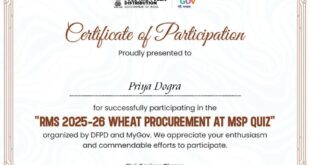Certiprof Lean Six Sigma White Belt Professional Certification Exam Answers
In this certification, the candidate will be able to learn the basics of Lean Six Sigma, understand basic statistical concepts related to this methodology, identify the steps of the DMAIC cycle, and understand the basic concepts to achieve process improvement.
Learning Objectives:
Enable students to learn about the fundamental concepts of Lean Manufacturing and Six Sigma
Audience Profile:
- Quality Managers
- Managers and heads of continuous improvement
- Industrial engineers
- Process engineers
- Any professional who wishes to learn about continuous improvement methodologies
Exam Details: Lean Six Sigma White Belt Professional Certification
- Format: Multiple choice
- Open Book: No
- Questions: 40
- Language: English
- Passing Score: 80%
- Duration: 60 minutes
- Delivery: This examination is available Online
Question 1: DMAIC is a methodology:
- Synchronous.
- Cyclical.
- Is performed once.
- Cascade.
Question 2: Choose the correct order of the Lean Six Sigma certifications:
- Champion, White, Yellow, Green, Green,Black, Master Black.
- White, Green, Yellow, Black, Master Black, Champion.
- White, Yellow, Green,Black, Master Black.
- White, Yellow,Green, Black, Master Black, Champion.
Question 3: Correctly order the phases of the DMAIC cycle:
- Define, Measure, Analyze, Control, Improve.
- Define, Measure, Analyze, Improve, Control.
- Measure, define, analyze, improve, control.
- Define, measure, improve, analyze, control.
Question 4: Under the lean manufacturing system, _______ wastes are identified:
- 7.
- 6.
- 5.
- 2.
Question 5: The X in the formula Y = f (x) represents:
- Output.
- Causes.
- The problem.
- Sigma level.
Question 6: The duration of a call is part of the data.
- Continuous.
- Continuous and Discrete.
- Evaluated.
- Discrete.
Question 7: The organization adopting Six Sigma is in an undefined process of:
- Scrum.
- Strategic organization.
- Continuous improvement.
- None of the above.
Question 8: Continuous data is:
- Evaluated.
- Measured.
- Verified.
- Counted.
Question 9: Six Sigma is a discipline that measures:
- Effectiveness.
- Process Capability.
- Attributes.
- A and B are correct.
- A and C are correct.
Question 10: Making decisions to change the current situation is part of:
- Measure.
- Improve.
- Control.
- Analyze.
Question 11: Producing too much in advance corresponds to waste:
- Extra-processing.
- Waiting.
- Overproduction.
- Transportation.
Question 12: The squared difference of each value from the mean is:
- Variance.
- Standard Deviation.
- Range.
- Mean.
Question 13: What are the phases of the DMAIC cycle?
- Define, Measure, Analyze, Improve, Control.
- Define, Measure, Analyze, Organize, Control.
- Define, measure, analyze, improve, check.
- Define, analyze, improve, control.
Question 14: The arithmetic average of a group of values refers to:
- Mean.
- Spread.
- Mode.
- Median.
Question 15: Repetitions of work corresponds to waste:
- Rework.
- Transportation.
- Overproduction.
- Motion.
Question 16: Standardization of the number of defects at the opportunity level is a concept of DPMO:
- Waste.
- Lean.
- DPMC.
- DPMO.
Question 17: Which of the following is not a working characteristic of the Yellow Belt?
- Knowing the basic concepts of Lean Six Sigma.
- Assist Green Belts in specific processes.
- Project Management.
- All of the above.
Question 18: The Y in the formula Y = f (x) represents:
- Causes.
- The problem.
- Sigma level.
- Input.
Question 19: The role of the White belt must be aware of:
- Project management.
- The basic concepts of Lean Six Sigma.
- Identify what about the process is not working as it should.
- All quality tools.
Question 20: The greater the variation in the data, the_______ the sigma level.
- Higher.
- Lower.
- Both options.
- None of the above.
Question 21: The Master Black Belt’s role must: Choose all of the correct answers (multiple possibilities).
- Train black belts and green belts.
- Have many years of experience.
- Add resources to the project.
- All of the above.
Question 22: The value that is repeated the most times in a group of data refers to:
- Mode.
- Spread.
- Median.
- Mean.
Question 23: The role of the Black Belt must: Choose all of the correct answers (multiple possibilities).
- Add resources to the project.
- Know the basic concepts of Lean Six Sigma.
- Lead a team.
- Manage the project.
- All of the above.
Question 24: The result of the visual defect inspection is:
- Discrete Data.
- Diminished data.
- Continuous Data.
- Attributes.
Question 25: What is the meaning of DPMO?
- Number of opportunities in a sample divided by the total number of defect opportunities multiplied by 1million.
- Number of defects in a sample divided by the total number of defects of defects multiplied by 1million.
- Number of defects in a sample divided by the total number of defect opportunities multiplied by 1million.
- Number of opportunities in a sample divided by the total number of defects of defects multiplied by 1million
Question 26: Define is the phase in which:
- Define root cause.
- Define KPIs.
- Analyze the data collected.
- The problem to work on is clearly defined.
Question 27: Analyzing the collected data to identify the root cause is part of:
- Analyze.
- Improve.
- Measure.
- Control.
Question 28: What are the most interesting elements of the data?
- Shape, center and spread.
- Shape and limits.
- Spread and limits.
- Shape and spread.
Question 29: Descriptive statistics is:
- Interpret and draw conclusions from the population.
- Evaluate the data.
- Evaluate control limits.
- Understand or map data from a sample or population.
Question 30: Process capability is equal to:
- ±6σ
- ±3σ²
- ±6σ²
- ±3σ
Question 31: The square root of the variance is:
- Median.
- Standard Deviation.
- Variance.
- Mean.
Question 32: Six Sigma uses the ______ method for continuous improvement.
- Scrum.
- DMAIC.
- Lean.
- None of the above.
Question 33: Discrete data is:
- Counted.
- Measured.
- All of the above.
- None of the above.
Question 34: What company created Six Sigma?
- Apple.
- Lenovo.
- Motorola.
- Toyota.
Question 35: Work not perceived by the customer corresponds to waste:
- Extra-processing.
- Motion.
- Overproduction.
- Transportation.
Question 36: The error _________ when the sigma level ______
- Decreases, Increases.
- Decreases. Decreases.
- Increases, Increases.
- None of the above.
Question 37: Controlling the implementations and ensuring compliance with the proposed objectives is part of the cycle:
- Lean.
- DMAIC.
- Scrum.
- None of the above.
Question 38: Controlling is the phase in which:
- We record the selected data.
- We analyze metrics.
- We identify the root cause.
- We follow up on the implemented actions.
Question 39: Choose the measures of dispersion: Choose all of the correct answers (multiple possibilities).
- Variance.
- Mean.
- Range.
- None of the above.
- All of the above.
Question 40: Analyze is the phase in which:
- Measure parameters.
- Define KPIs.
- Identify the reasons why something is going wrong.
- The problem to be addressed is defined.
Question 41: Which of the following is not a working characteristic of a Green Belt?
- Identify what in the process is not working as it should.
- Identify the root cause of a problem.
- Adding resources to the project.
- All of the above.
Question 42: Identifying the right targets and root causes is done with the DMAIC methodology:
- Lean.
- DMAIC.
- DPMO.
- Six Sigma.
Question 43: Six sigma is a methodology oriented to:
- Waste.
- The data.
- Overprocesses.
- Processes.
Question 44: Inferential statistics is:
- Understand or map data from a sample or population.
- Evaluate the data.
- Evaluate samples.
- Making decisions about a population based on the parameters or characteristics of a sample.
Question 45: Ensuring that improvements are implemented and objectives are met is part of:
- Analyze.
- Measure.
- Control.
- Check.
Question 46: Who of the following is considered the father of the Lean methodology?
- Bob Galvin.
- Bill Smith.
- Taiichi Ono.
- None of the above.
Question 47: Without the correct definition, that is done in the phase of _______ , it is not possible to establish metrics.
- Analyze.
- Control.
- Measure.
- Define.
Question 48: Identifying the value stream is part of which Lean methodology?
- Lean.
- Lean Six Sigma.
- Six Sigma.
- None of the above.
Question 49: Collecting metrics that help to know the situation of the problem is part of which DMAIC cycle?
- Control.
- Measure.
- Analyze.
- Improve.
Question 50: In which phase is the problem to be solved defined?
- Measure.
- Define.
- Analyze.
- Control.
Question 51: The number of times a customer hangs up a call is part of the data.
- Discrete.
- Evaluated.
- Continuous.
- Continuous and Discrete.
Question 52: On-time delivery and minimum use of resources is the basis for:
- Lean Six Sigma.
- Lean Methodology.
- DMAIC.
- Six Sigma.
Question 53: Improve, is the phase in which:
- We make decisions to analyze the root cause.
- Analyze metrics.
- We set control limits.
- Make decisions that lead to change the current situation.
Question 54: Any movement that does not add value corresponds to waste:
- Extra-processing.
- Waiting.
- Sigma.
- Motion.
Question 55: The role of the Yellow Belt must: Choose all of the correct answers (multiple possibilities).
- Knowing the basic concepts of Lean Six Sigma.
- Project management.
- Support Green Belt in specific processes.
- Identify what about the process is not working as it should.
Question 56: A process that operates at 6 Sigma level is a process that:
- It’s off the charts.
- It has poor performance.
- It has a 99.9% performance.
- None of the above.
Question 57: The higher the Sigma level, the:
- Largest number of DPMO.
- Least number of DPMO.
- Level and Number of DPMO equal.
- None of the above.
Question 58: Six standard deviations from the mean value is:
- Six Sigma.
- Variance.
- Sigma.
- Lean.
- Range.
Question 59: Choose the measures of central tendency: Choose all of the correct answers (multiple possibilities).
- Median.
- Mode.
- Range.
- None of the above.
- All of the above.
Question 60: Characterizing data from a population is the definition for:
- Descriptive Statistics.
- Inferential Statistics.
- Statistics.
- Differential Statistics.
Question 61: What are the wastes mentioned in the Lean methodology?
- Overproduction, transportation, inventory, scrap, extra-processing, rework, motion.
- Overproduction, transportation, inventory, waiting,extra-processing, rework, motion.
- Overproduction, transportation, inventory, waiting, extra-processing, push, pull.
- Overproduction, transportation, inventory, waiting, extra-processing, rework, suspect material.
Question 62: Choose the definition of Inventory as waste:
- Additional additions to the work.
- Any amount above the minimum necessary to get the job done.
- Repetitions of work.
- All of the above.
- None of the above.
Question 63: The central number of a group of numbers when ordered from largest to smallest refers to:
- Spread.
- Median.
- Mode.
- Mean.
Question 64: The Lean methodology is created in the century ____ for Toyota.
- X Century.
- 21st Century.
- 20th Century.
- XXV Century.
Question 65: Measuring is the phase in which:
- Reduce defects.
- Collect metrics to understand the situation.
- Analyze and define the problem.
- Analyze the information.
Question 66: Choose the best definition of Six Sigma.
- Methodology that aims to eliminate waste and improve processes.
- Methodology that seeks to improve processes.
- Methodology that seeks to reduce waste and improve processes.
- Methodology whose principle is to evaluate the wastes.
Question 67: The role of the Green Belt must:
- Identify what about the process is not working as it should.
- Knowing the basic concepts of Lean Six Sigma.
- Support Black Belts in specific processes.
- Identifying the root cause of a problem.
- All of the above.
Question 68: The Champion role must: Choose all of the correct answers (multiple possibilities).
- Put Lean Six Sigma processes and methods into practice.
- Evaluate metrics on a daily basis.
- Add resources to the project.
- All of the above.
Question 69: The resultant of a measure such as impedance is:
- Attributes.
- Discrete Data.
- Continuous Data.
- Diminished data.
Question 70: Making decisions based on the characteristics of a sample is the definition for:
- Differential Statistics.
- Statistics.
- Inferential Statistics.
- Descriptive Statistics.
 Priya Dogra – Certification | Jobs | Internships
Priya Dogra – Certification | Jobs | Internships



